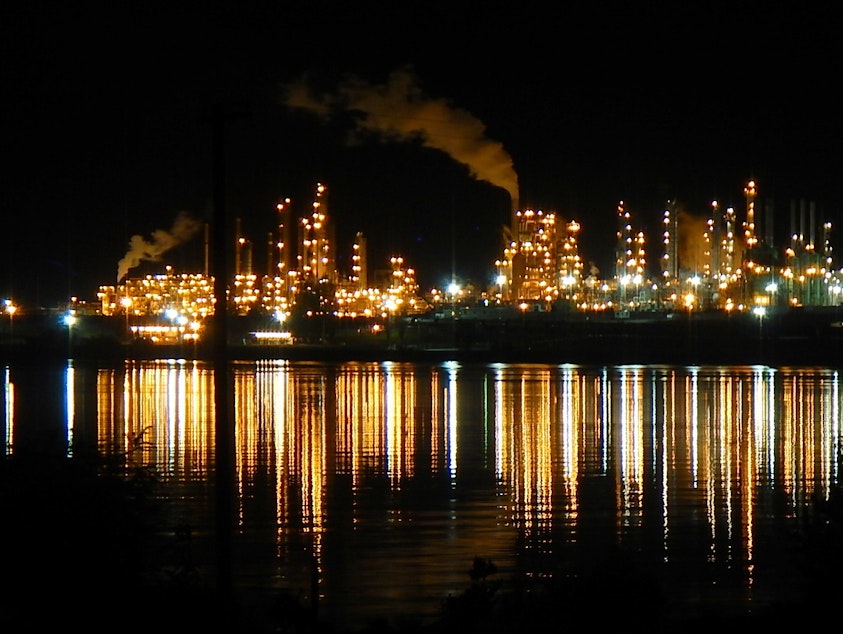Biden ban on Russian oil hits Anacortes, Washington refinery

Russian oil could be en route to Washington state for several more weeks despite a ban on Russian oil and gas imports imposed by President Joe Biden on Tuesday.
Industry officials say it could take a couple of months for oil to reach a refinery after it’s been purchased from international sources.
“The crude that was bought two or three months ago, some of it still may be on the way to the United States,” said Kevin Slagle with the Western States Petroleum Association.
Petroleum in Washington comes mostly from Canada, North Dakota, and Alaska, but the Marathon Petroleum refinery in Anacortes imported nearly 9 million barrels of Russian oil in 2021, more than the state’s four other oil refineries combined, according to the U.S. Energy Information Administration. That was about a fifth of all the crude oil processed by the refinery, according to an estimate from the environmental thinktank Sightline Institute.
RELATED: Biden announces Russian oil import ban and warns gas prices could increase even more
Though drillers have not produced crude oil in Washington state since the early 1960s, the five refineries on Puget Sound make Washington the fifth-largest refiner of oil in the nation, according to the Energy Information Administration.
Sightline estimates that crude oil purchases by Washington refineries yielded $700 million for Russia in 2021.
Sponsored
“Our status quo energy economy ties us to the ugly geopolitics of petrostates,” Sightline researcher Zane Gustafson writes. “The faster Cascadia gets off fossil fuels, the sooner we can stop financially enabling Russian aggression.”
The Marathon refinery was still importing Russian oil in mid-February, according to business news site S&P Global Market Intelligence, but that supply will dry up once tankers crossing the Pacific have delivered their goods.
In February, Marathon Petroleum reported fourth-quarter profits of $774 million, up nearly threefold from a year earlier.
Marathon-Anacortes spokesperson Matt Gill declined to be interviewed, referring KUOW to the Western States Petroleum Association, the trade association for most West Coast refineries.
Slagle, the trade association’s spokesperson, said the oil industry supports President Biden’s ban.
RELATED: As gas prices surge, here's how to get the most out of your tank
Though oil prices have been spiking around the world, not just in the United States, Republicans including Washington Rep. Dan Newhouse said the Biden Administration’s domestic energy policies are to blame.
“These rising prices started long before this conflict, and we will continue to hold this administration accountable for the burden they have placed on the American people,” Newhouse said.
“Even amid the pandemic, companies in the United States pumped more oil during my first year in office than they did during my predecessor’s first year,” Biden said during his announcement of the ban.
The U.S. Energy Information Administration forecasts rising domestic oil production in 2022 and record levels in 2023.
While oil industry supporters say the U.S. should further expand domestic oil production, environmentalists say the Russian invasion heightens the urgent need to transition away from fossil fuels that are rapidly destabilizing the planet’s climate.
Sponsored
“You can either be for stopping climate breakdown, or for boosting oil and gas production,” NASA climate scientist Peter Kalmus tweeted. “Not both.”
Many politicians, pundits, and news stories have claimed that gas prices have hit record highs in recent weeks, but those claims ignore inflation — a critical mistake to make when comparing prices over time.
Average gas prices peaked at $4.35 a gallon in Washington state in July 2008, according to the American Automobile Association. That is equivalent, after adjusting for inflation, to at least $5.56 per gallon today (using the Consumer Price Index for January 2022, the most recent available from the U.S. Bureau of Labor Statistics).
According to AAA, gasoline retailed for an average of $4.63 per gallon in Washington on the morning of March 9, nearly a dollar shy of the inflation-adjusted 2008 peak.




